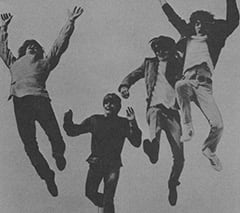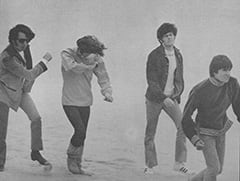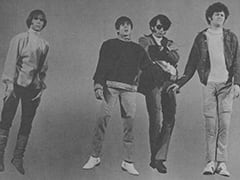
Eighteen year [sic] after its theater release, the enigmatic Head—the Monkees’ only feature film—is available on video. That demand for the film was fueled by the Monkees’ bizarre 1986 success is unquestionable. What’s open for question (again) is the film’s worth and, in a way, the ultimate worth of the Monkees themselves.
People have pondered the merits of Head since its 1968 debut—at the time, some felt it was a work of genius and others regarded it gratuitous psychedelic tripe. Most everyone agreed it was weird, and the paying public pretty much rejected it flatly. Head was a financial flop and is now generally looked upon as the Monkees’ swan song.
Well, time lends perspective. Watching Head in the mid-’80s is a strange experience—much stranger than watching Help!, Gimme Shelter, Woodstock, or just about any rock film from the same era. With its narrow focus on the Monkees—certainly the era’s most despised rock group—Head reveals some bitter truths about rock stardom, or (since we’re talking about the Monkees here) simply stardom. It’s a dark movie, a deeply cynical movie, and—ultimately—a remarkably accurate assessment (and forecast) of what this rock business was becoming. That it was the culmination of the Monkee experience makes it all the more remarkable: really, the Monkees funneled their unique knowledge (a knowledge even Presley and the Beatles couldn’t have had) into a funhouse mirror. And it sure ain’t a purty sight.

Head is essentially a series of vignettes that, one supposes, presents the Monkees as they wanted to be perceived. What surprises here is how gosh-darned testy the boys are: when a commissary waitress asks Micky Dolenz if he’s still paying homage to Ringo Starr, he tersely asks her if she’d like a fat lip. When the cast and crew of Head throw a surprise birthday party for Mike Nesmith, he denounces the proceedings and storms out in a rage. And, of course, the movie opens and closes with the Monkees attempting suicide by jumping off a mighty high bridge.
And people say they monkey around.
Which isn’t to say there aren’t some lighter moments… a good one to watch for is the scene where Peter Tork strolls into the bathroom where Davy Jones is flipping out: Tork’s whistling “Strawberry Fields.” Dolenz’s “Western scene”—where he brushes aside palpably fake arrows and walks through a palpably fake Western backdrop, telling the producer he’s sick of such b.s.—is typically great Monkee hijinks. As is Tork’s “war scene,” where ex-Green Bay Packer Ray Nitschke pounds him in a gridiron frenzy. Tork’s befuddlement is priceless.

But levity is far from the keynote of Head. Nor is music—despite the inclusion of the beautiful “Porpoise Song” and Nesmith’s “Circle Sky”—the score features a meager six songs. No, the point here seems to be the Frankensteinian Monkees, who lash out at the film milieu as readily as they take on the music biz. (This surely with some input from director Bob Rafelson and co-writer Jack Nicholson.) In addition to being virulently anti-war (the scenes of the Monkees performing “Circle Sky” live, with superimposed images of Vietnam and screaming girls are pretty chilling), Head is anti-rock and anti-fame. In fact, it’s so self-mocking that it borders on tragedy. For the Monkees to chant: “You say we’re manufactured/To that we all agree/So make your choice and we’ll rejoice in never being free/Hey, hey we are the Monkees/We’ve said it all before/The money’s in, we’re made of tin/We’re here to give you more” is almost too much. The final irony—that few gave them any due at all for this public gut-spilling—is, like, fitting. Scary, too.
So, yes, Head is very worthwhile. If you’re a fan of the TV Monkees you might not dig it all. But if you’re a fan of rock, popular culture or this wonderful and wild country, it’s a must-see.

